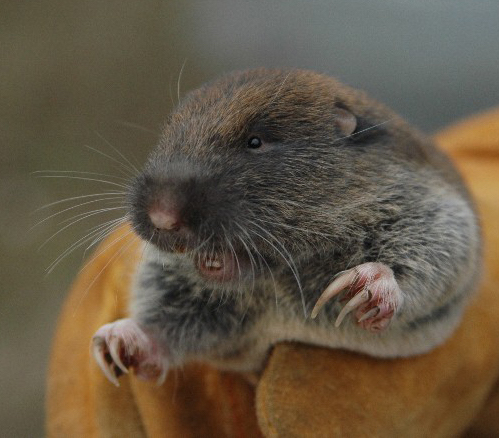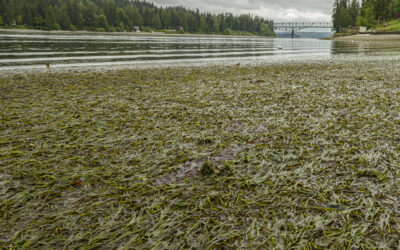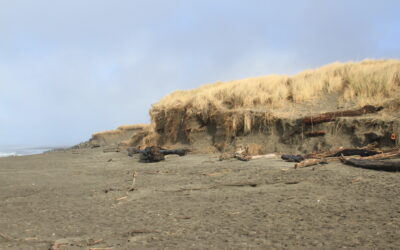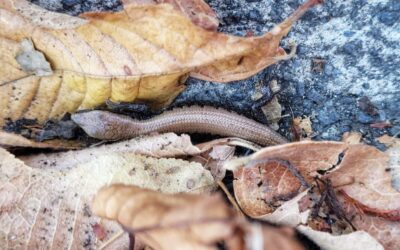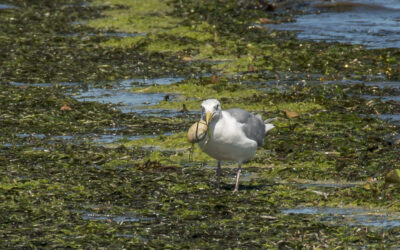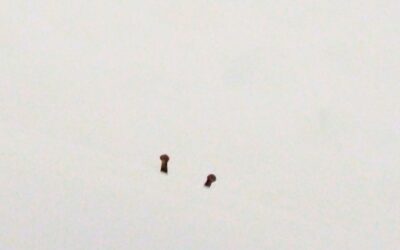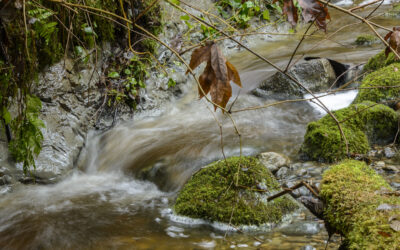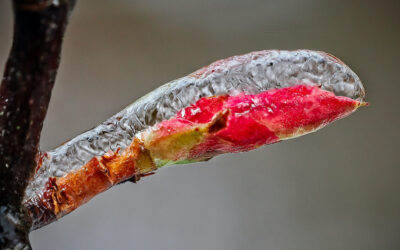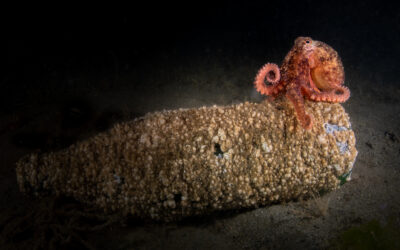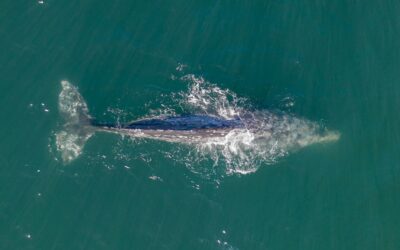ECOSYSTEM ENGINEERS
by Amy Porter, Spring 2023
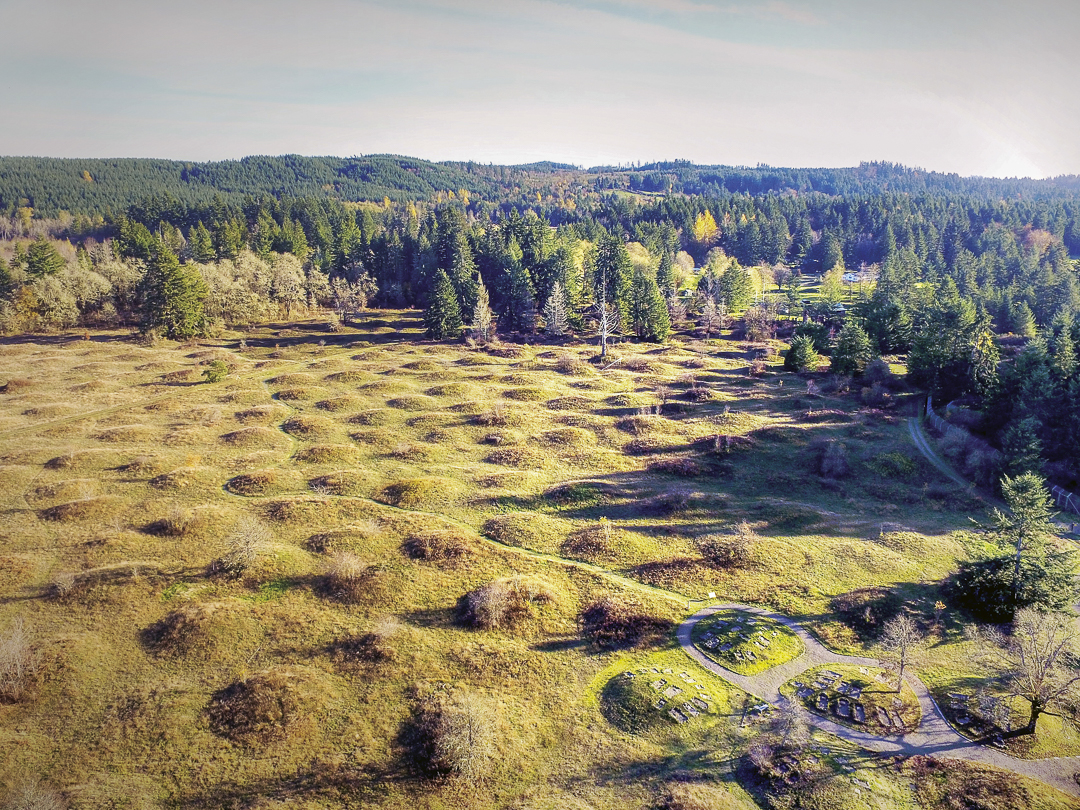
Wolf Haven mounded prairie. photo by Wolf Haven International
ECOSYSTEM ENGINEERS
by Amy Porter, Spring 2023
On Wolf Haven’s mounded prairie, there is an underground movement happening that largely goes unnoticed — bioturbation (the movement of soil) by Mazama pocket gophers (Thomomys mazama) excavating their homes. At only eight inches long and weighing less than 100 grams, Mazama pocket gophers are forces of nature. The typical pocket gopher can move 3–7 tons of soil every year as they build and maintain their territories, which consist of a network of tunnels with separate chambers for storing food, nesting, and depositing excrement.
Wolf Haven’s prairie is covered with mima mounds — small, domelike hills with a mysterious origin. Dozens of hypotheses have been proposed about their creation, including pocket gopher activity, events associated with glacial melt, earthquakes, even aliens! Despite decades of inquiry, there is still no consensus on how they were formed but pocket gopher activity continues to be argued as a possibility.
Pocket gophers are considered “ecosystem engineers” because their movement of soil alters the soil’s structure and chemistry, which in turn affects plant community composition and dynamics. As organic surface matter gets buried by mounds, it gets mixed into the subsoil along with decomposing food caches and excrement, creating an infusion of nutrients. The mixing of materials increases the soils nitrogen and phosphorous content, which provides deep fertilization for plants. On the Salish prairies, Mazama pocket gophers play a role in maintaining plant species richness and diversity, particularly the abundance of forbs (herbaceous flowering plants) on the landscape. Some studies have found where pocket gophers occur, plant species diversity can increase by 5-48%. White-topped aster (Aster curtus), a sensitive species on Salish prairies, is one of several native species that can benefit from Mazama pocket gopher activity.
In some areas, however, non-native forbs outcompeted native species around pocket gopher mounds. Soil disturbance often favors early successional species, many of which are weedy exotics that effectively exclude native species. Local conditions and surrounding plant communities likely influence the prevalence of native verses non-native species found around mounds. There is still much to be learned about the synergy between pocket gophers and plant community dynamics in supporting healthy ecosystems.
Mazama pocket gopher’s movement of soil contributes to the hydrological system. As they excavate their tunnels, they loosen and aerate the soil, increasing water infiltration and percolation. Their tunnels and surface mounds also move and redistribute water to help control runoff and soil erosion.
Many critters also benefit by sharing the landscape with pocket gophers. Numerous amphibians, reptiles, small mammals, and invertebrates use unoccupied burrows as refuge from predators and/or retreat from the elements. In areas where pocket gopher numbers are high, they are a food source for predators, such as coyotes, fox, bobcats, weasels, snakes, hawks, and owls.
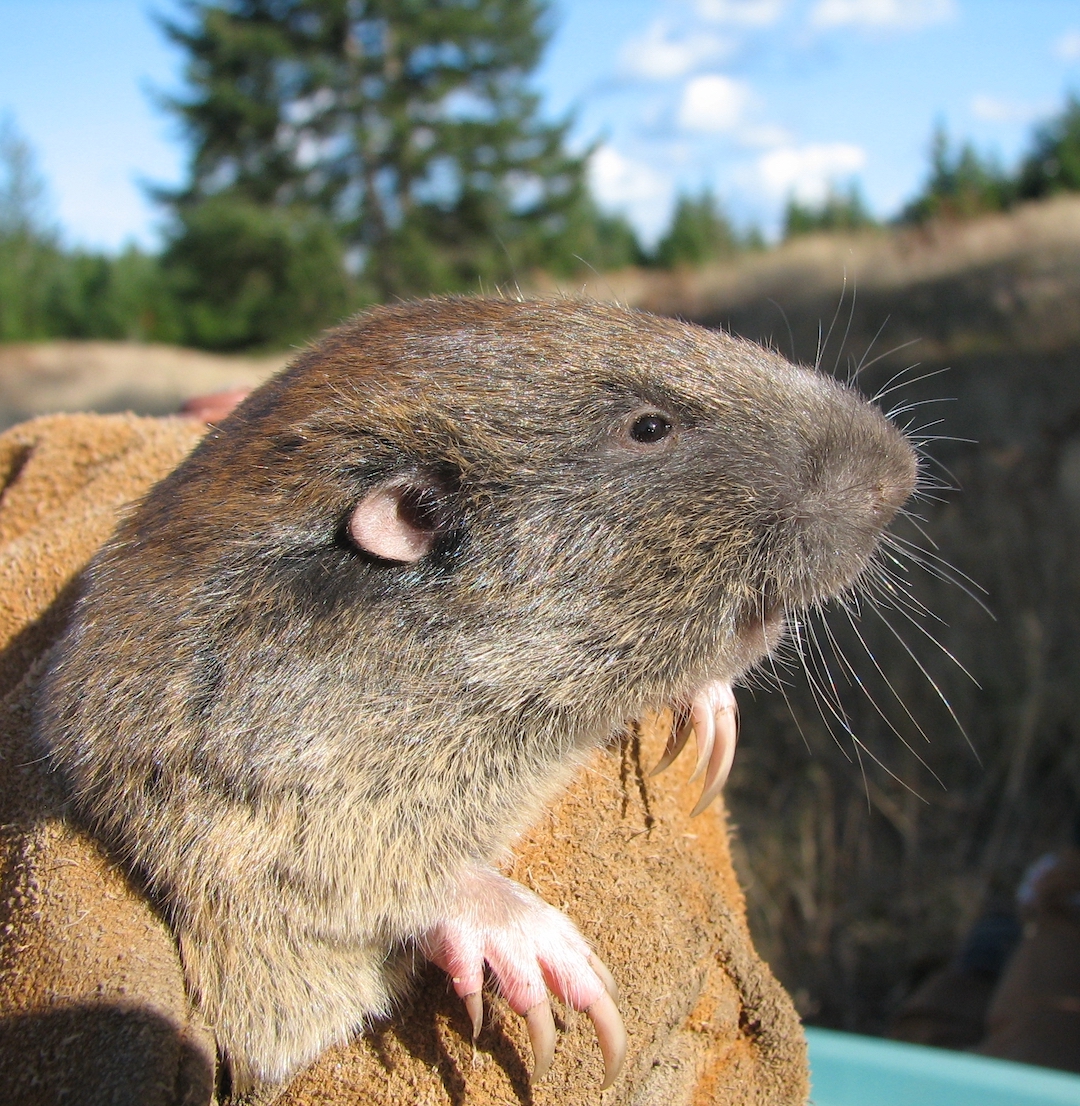
Mazama Pocket Gopher. photo courtesy of WDFW, USFW, Wolf Haven
The Mazama pocket gopher is a regional endemic species, found only in western Washington, western Oregon, and northern California. It’s distribution and abundance in the Salish region correlates with areas that have well-drained glacial outwash soils (deposits of sand and gravel that were carried by running water from melting glacial ice) and herbaceous vegetation (plants without persistent woody stems), many of which were historically prairies. Much of their historical habitat has been degraded by scotch broom (Cytisus scoparius), fragmented, or lost to forest succession, agriculture, and development.
In Washington, the Mazama pocket gopher is represented by six subspecies. Four of the six subspecies are listed as federally threatened under the Endangered Species Act. Along with habitat restoration efforts, translocation (moving an animal from one site to another) has been another component of their conservation. From 2005–2008, 193 individuals were captured from two sites slated for development prior to their listing, then translocated to Wolf Haven’s 32 acres of mounded prairie. Translocation efforts are challenging, in part because individuals are highly susceptible to predation as they begin to establish new territories. Based on the Fall 2015 mound surveys, the Wolf Haven population was estimated at 600 individuals.
While Mazama pocket gophers are not restricted to prairie habitat, soil conditions affect where they can carve out a living. Soils that are rocky and/or have a high clay content can create numerous obstacles. Mazama pocket gophers are vigorous critters, but large rocks can be a struggle to move and can decrease burrowing efficiency. Soils that are high in clay have very low permeability and often become waterlogged, which can result in periodic flooding of burrows. Waterlogged soils also deprive both pocket gophers and plant roots of oxygen. Furthermore, while clay particles bind well with nutrients, it is hard for plants to extend their roots through them, affecting plant productivity and subsequently Mazama pocket gopher nourishment.
Pocket gophers are well adapted to their largely subterranean life. They have strong claws on their front feet and prominent incisors to dig through the soil and cut roots. They can close their mouth behind their incisors, allowing them to loosen soil with their teeth without swallowing dirt. External, fur lined cheek pouches on both sides of their mouth enable them to transport seeds and plant material gathered while foraging underground. Narrow hips, short limbs, and loosely attached skin facilitate their movement through tunnels, including turning around in tight spaces. They can even move backwards almost as fast as they move forward. They have tiny eyes and ears, but sensitive whiskers and a sparsely haired tail provide the sensory awareness needed to move through the darkness. Life underground, however, can be energetically expensive. Movement through soil costs far more energy than traversing the same distance on the surface. Pocket gophers fuel their activity by consuming large quantities of plant material, primarily roots, but also surface vegetation.
Mazama pocket gophers are highly asocial. Males and females maintain their own burrow systems and are intolerant of other pocket gophers in their burrows, except during the mating season and prior to weaning young, who typically disperse around two months. If young pocket gophers are unable to expand from their mother’s burrow system to establish their own territory, they are sometimes required to move above ground to locate and secure a new territory. This can be a dangerous endeavor because movement above ground makes pocket gophers extremely susceptible to predation.
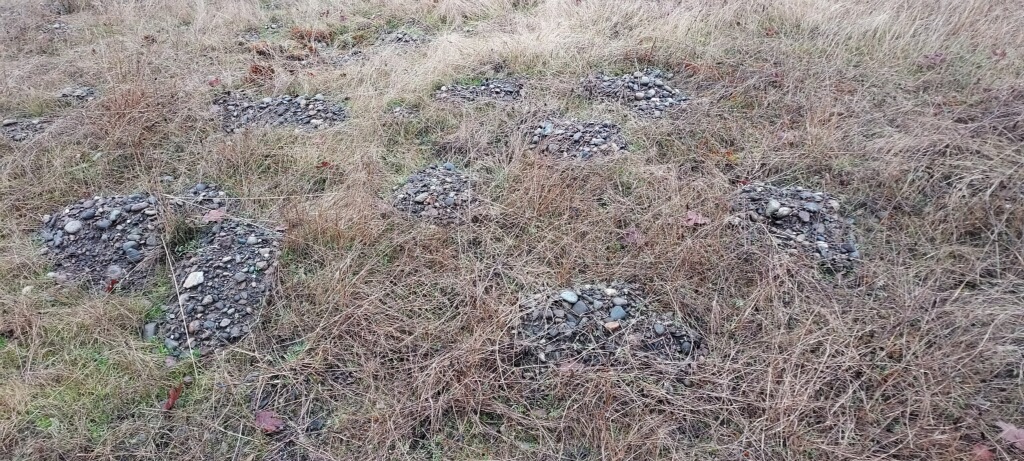
Gopher mound. photo by Wolf Haven International
While Mazama pocket gophers are rarely seen above ground, signatures of their movement are scattered around Wolf Haven’s prairie. Their mounds are visual microsites of soil disturbance that, to the untrained eye, can be confused with mole mounds. A few characteristics, however, can help distinguish them. Pocket gophers push soil up from inclined lateral tunnels, creating fan-shaped mounds whereas moles push soil up from vertical shafts, creating dome- or volcano-shaped mounds. Pocket gopher mounds tend to be distributed in irregular piles while mole mounds are more evenly distributed. And, unlike moles, pocket gophers maintain a sealed burrow system by plugging entrances with soil, which helps deter predators. Sealed burrows create an environment low in oxygen and high in carbon dioxide, which pocket gophers are physiologically adapted to tolerate.
Life moving through the underground often escapes our attention but if you are patient and observant, you may catch a glimpse of something extraordinary. It may be a slight wiggle in the vegetation, followed by the entire plant disappearing underground. Perhaps you are among the lucky few that witness a pocket gopher briefly emerge on the surface, quickly cram its cheek pouches full of food, then vanish again. Even if you miss them though, their mounds remind us there is a mighty movement happening under those piles of dirt and that movement plays a key role in healthy ecosystem functioning.
FIND OUT MORE
Introducing… The Mazama pocket gopher: The story of 4 threatened subspecies in South Puget Sound, Washington. US Fish and Wildlife Story Map. This overview is a good visual accompaniment to the above article. It also shows on a map where Mazama Pocket Gophers call home.
Mazama pocket gopher vs. coast mole ID Card
Mazama Pocket Gopher Recovery Plan and Periodic Status Review.
Young Mazama pocket gophers struggle to find their place in a new world.
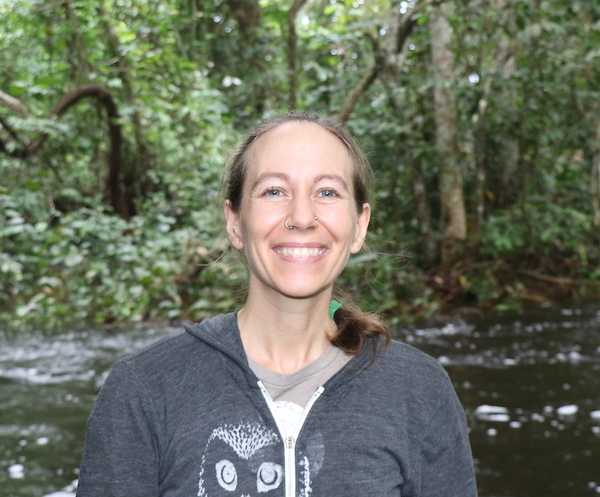
Amy Porter is a wildlife conservation biologist with 25 years of experience working on scientific research, nature-based education, and community conservation projects in the U.S., Caribbean, Latin America, and Africa. She grew up in Washington, close to the Salish Sea, and has been a passionate naturalist in the area since she was young. Amy has worked extensively with birds, otters, primates, and now wolves. Currently, she is the Director of Conservation at Wolf Haven International (https://wolfhaven.org) where she is involved with wolf and prairie conservation.
Table of Contents, Issue #19, Spring 2023
A Window on Eelgrass
by Kylie Rench, Spring 2023 photos by John F. Williams by Kylie Rench, Spring 2023 photos by John F. WilliamsLow tide opens a window for the beach walker onto the vibrant world of eelgrass meadows. Submerged by salt water during most tidal cycles, these meadows are...
Poetry-19
Spring 2023 photo by Thomas NolandSpring 2023Sand and Water by Jeffrey Hummel Sand infinite amountsappearing all the sameBlowing, shifting, changingAbrasiveA handful you can’t holdSlides through your fingersGets into everythingevery part of youEvery nook, crack...
Lizard’s Locomotion
by Karin Kersteter, Spring 2023 illustrations by Karin Kersteter by Karin Kersteter, Spring 2023illustrations by Karin KersteterThere is an expression “leave the leaves,” which is designed to encourage people to let leaves lie in yards and gardens, rather than rake...
Turbulence
by Rebekah Boettcher, Spring 2023 photos by Rebekah Boettcher except as noted Seagull with clam. photo by John F. Williamsby Rebekah Boettcher, Spring 2023 photos by Rebekah Boettcher except as notedHow did I get here? I ponder, stunned once again as we walk down to...
Learning from a Snail’s Pace
by Michelle Ryder, Spring 2023 Photos by Michelle Ryder except as noted Mapfire peering over the side of the bathtub from inside of it.by Michelle Ryder, Spring 2023 Photos by Michelle Ryder except as notedIn 2022 a snail came into my life. And stayed. Late last...
Movement Imagery
Spring 2023 Cowling Creek, Suquamish. photo by John F. WilliamsSpring 2023Here is a collection of photos and art work depicting various kinds of movement. You may enjoy playing the audio file below as you view the photos. The music evokes the feeling of motion through...
Plant motion
text and photos by John Bolivar, Spring 2023 Ribes sanguineum floral bud encased in ice.text and photos by John Bolivar, Spring 2023At first look it would appear that plants do not have the luxury of movement to help them avoid bad weather — like our recent bout of...
2022 Photo Challenge
by MaST Center Aquarium, Spring 2023 Jurors' Favorite - On the Bottle, Veronika Nagy. Small octopus sitting on a bottle. by MaST Center Aquarium, Spring 2023The Underwater Photography Challenge focuses on bringing divers to Redondo Beach, Washington, to highlight the...
Gray Whales
by Laura Marx, Spring 2023 Gray whale off the Oregon coast. photo by Dan Meyers on Unsplash by Laura Marx, Spring 2023Gray whales and their amazing migrations up and down the west coast of the U.S. have made an impact in my life ever since I was a child. In the 1990’s...
PLEASE HELP SUPPORT
SALISH MAGAZINE
DONATE
Salish Magazine contains no advertising and is free. Your donation is one big way you can help us inspire people with stories about things that they can see outdoors in our Salish Sea region.
We also don't advertise Salish Magazine, so please spread the word of this online resource to your friends and colleagues.
Thanks so much for your interest and your support.
We also don't advertise Salish Magazine, so please spread the word of this online resource to your friends and colleagues.
Thanks so much for your interest and your support.

